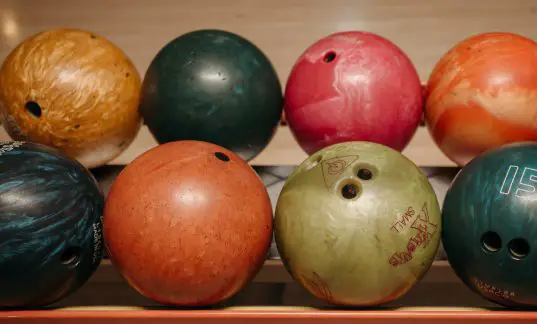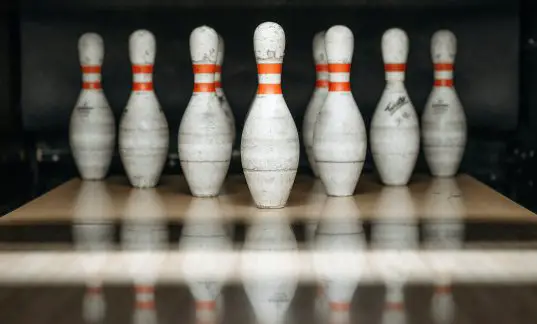While the modern bowling alley has become an integral part of international leisure and sport in recent generations, it’s only one locale for one chapter of the history of bowling games around the world. The concurrent histories of nine-pin bowling, tenpin bowling, and all of the various iterations of the bowling game span thousands upon thousands of years. Before the first rubber ball and before the advent of dedicated bowling alleys, people around the globe turned many a spherical object into defacto bowling balls.
And before championship bowling and the birth of the Professional Bowlers’ Association and Women’s National Bowling Association, the story of how bowling began took countless twists and turns through grass, dirt, and finally onto wood and synthetic bowling lanes.
As a celebration of the modern game we all know and love, we’re here to tell the fascinating story of the sport of bowling. Before you head back to the bowling center and lace up your bowling shoes for another night of league play, why not learn about the birth and growth of the sport of kings.
Ten-Pin Bowling in Ancient Times (5200 BC to 4 AD)
According to several historians and professors with an eye on ancient civilizations, bowling history may go over 7,000 years back to the heyday of Ancient Egypt. Per Sir Flanders of Petrie, former emeritus professor of Egyptology at the University of London, a rudimentary tenpin bowling set was found in an Egyptian child’s grave near the turn of the 20th Century.
While we already knew by that point that bowling had a long and rich history, the uncovering of a bowling ball and bowling pins at the gravesite of an Egyptian child was quite the revelation. Before the modern bowling lane was even a twinkle in the universe’s eye, the history of bowling began with a version of the tenpin sport somewhere around 5200 BC or before.
Diving deeper into the advent of elementary bowling technology, head curator of the San Diego Museum of Man, Dr. Malcolm Rogers, uncovered the rules of the ancient Polynesian game of “Ula Maika.” Using small elliptical bowling balls and flat stone discs, players attempted to know down nine or ten pins from a distance of 60 feet — the same distance between the foul line and pins in tenpin bowling.
Before modern wooden pins and synthetic options were in use, ancient civilizations worked through many different materials to find the right composition for a pin. One basic form of bowling after another cropped up until 400 AD, with the actual birth of ninepins and ten-pin bowling not far off.
Nine Pins and the Birth of Modern Bowling (4 AD – 1500 AD)
Around 4 AD, the annals of modern bowling began in Western Europe. In Paderborn, Germany, a form of bowling was played as a religious ceremony in the cloisters of cathedrals. Parishioners were asked to place all the pins given to them on one side of the cloister. These nine pins (Kegels) embodied the “Heide,” or heathen spirits. Parishioners were then coaxed to roll their bowling balls, sans finger holes, at the “Heide.” If they could hit the pins, they were deemed pure of heart and seen as capable of withstanding/slaying the heathen spirits.
This is was more akin to a regimented game of ninepins than the tenpin game, but they proved quite popular in their day. As the centuries wore on, games of bowling with as few as three pins and as many as 17 were played throughout Western Europe, Asia, and other parts of the world.
This all led to the first written record of bowling in 1366. At that juncture, bowling was played outdoors and enjoyed by English citizens of all classes. Played on a bowling green, lawn bowling was a growing and flourishing part of English society. However, King Edward III was infuriated by how the game interfered with his soliders’ time for archery practice. Thus, King Edward III banned bowling in hopes of quieting the sound of fallen pins around his kingdom.
It didn’t work. The game continued to grow and evolve, albeit illegally for the first hundred years or so. King Henry VIII amended the bowling ban to include nobility in 1511, but the game was still played underground in England until the ban was officially lifted in 1845.
By then, a new form of bowling called “skittles” was introduced and played on smooth surfaces of dirt with nine wooden pins. Also played on tabletops after a while, this evolved type of bowling was one of the direct predecessors of modern bowling and the first true bowling boom.
The First Bowling Boom Reaches New York City, The World (1500-1917 AD)
A reproduction of a painting housed in New York City’s Bettimann Archives features Dutch immigrants throwing bowling balls on Bowling Green in New York around 1650. The game of bowling likely reached the Americas well before that, but it was the first documented appearance of the game in the Colonies.
Ninepins continued to grow in America in the 17th and 18th Centuries — well before the age of pro bowlers, league bowling, and synthetic wood playing surfaces. By 1820, ninepins had gained traction as the preferred form of bowling around the United States. And by 1850, gamblers had a stranglehold on the game and the cash flow the game generated.
The birth and flourishment of tenpin bowling remain murky from a timeline perspective. There were so many regional clubs and so many different regulations within each of them. However, the birth of the American Bowling Congress at Beethoven Hall in New York City on September 9, 1895, helped to standardize tenpin bowling as the obsession of every avid bowler in the United States (and then, the world.) It galvanized the various bowling clubs around the nation and organized things for the greater good,
The problem here, though, was that the American Bowling Congress was strictly created for men. Women were left out of the official bowling fun, leading to the 1917 creation of the Women’s International Bowling Congress in St. Louis, Missouri.
That’s when the fun started for everyone.
Bowling Clubs and Bowling Alleys, A New Favorite Sport (1918 AD – Present Day)
By the inception of the WIBC, bowling technology was on the rise. Previously, bowling balls were crafted of lignum vitae — a very hard wood that was prone to losing its shape with repeated play. In 1905, the “Evertrue” rubber bowling ball hit the market with stellar reviews. Within ten years, Brunswick began its bowling equipment empire with the introduction of the mysterious Mineralite ball — one of the most popular balls of the early 20th Century.
With rubber balls and improved wooden lane conditions, bowling boomed for a second time. The Golden Age of Bowling from around 1940 through the 1970s brought the game into nearly every community and millions of households around the world through the art of television. As countries around the globe worked through the physical and emotional wounds of World War II during and after wartime, the sport of bowling proved a beautiful respite.
And as bowling began to proliferate widely, a host of organizations were born to capitalize on and organize bowling’s growing popularity. The International Bowling Association opened in 1926 and helped to coordinate international amateur competitions.
The American Junior Bowling Congress (1946) and the Young American Bowling Alliance (1982) were a boon for youth competitions in the same way.
Yet, the real key to the skyrocketing popularity of bowling in the 1960s and 1970s in particular was the rise of pro bowlers. With the advent of the Professional Bowling Association (1958) and the Professional Women’s Bowling Association (founded in 1960, later to become the Ladies’ Pro Bowlers Tour in 1981), top male and women bowlers competed for massive cash prizes on network television to the delight of a captivated populace.
This led to benchmark events like the PBA National Championship (later to become the PBA World Championship) — an infamous bowling tournament that has created many a legend and celebrity in the world of bowling.
And while bowling has hit a bit of a rough patch due to social-distancing regulations during the COVID-19 pandemic, it is still one of the most widely-loved sports in the world! It’s played by over 95 million folks in nearly 100 countries across the globe.
Nowadays, bowling history is continuing to shape itself in new ways. And while this article couldn’t cover every single historical marker in the game’s rich lineage, the new digital age will make sure that we can relive the third boom of bowling over and over when it inevitably comes along.

